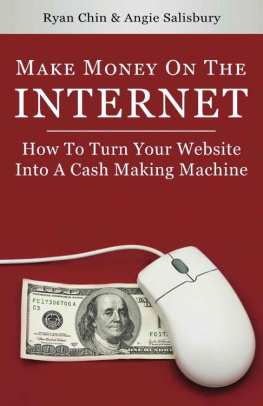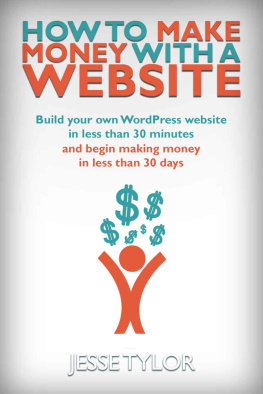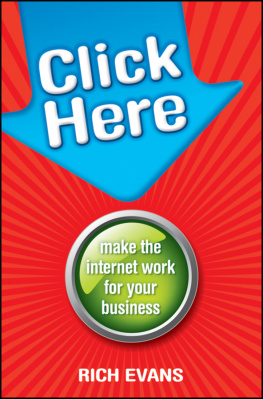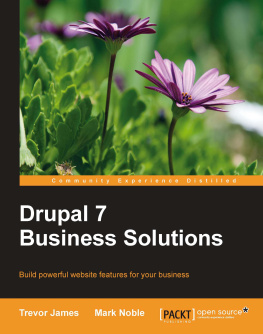Make Money on the Internet
HOW TO TURN YOUR WEBSITE INTO A CASH MAKING MACHINE
Ryan Chin
Angie Salisbury
Think Strategy Inc.
Seattle, WA
Copyright 2014 by Think Strategy Inc.
All rights reserved. No part of this publication may be reproduced, distributed or transmitted in any form or by any means, including photocopying, recording, or other electronic or mechanical methods, without the prior written permission of the publisher, except in the case of brief quotations embodied in critical reviews and certain other noncommercial uses permitted by copyright law. For permission requests, write to the publisher, addressed Attention: Permissions Coordinator, at the address below.
Think Strategy Inc.
6727 Seward Park Ave. S.
Seattle, WA 98118
www.thinkstrategy.com
Ordering Information:
Quantity sales. Special discounts are available on quantity purchases by corporations, associations, and others. For details, contact the Special Sales Department at the address above.
Make Money on the Internet. 1st ed.
Contents
Thanks to my husband and family for always believing in me and to my two German Shorthaired Pointers for being the greatest sounding boards ever. Look out, its your turn next.
~ Angie
Dedicated to my family who taught me the importance of helping others.
~ Ryan
Part One
What Differentiates Sites That Sell Well From Ones That Dont?
[1]
Beauty Is Only Code Deep
Beautiful websites can earn you and your company appreciation and recognition from visitors.
Unfortunately, admiration doesnt necessarily lead to sales.
Dont get us wrong, wed rather have a great looking website than an ugly one. Its just that the beauty is negligible if youre more focused on style and aesthetics but dont think about usability.
Are you too focused on creating a piece of art rather than a functional tool that sells? Do you want people to be impressed with your taste level or do you want them to buy from you?
Its kind of like when youre trying to sell a house and you spend all your money on things that look good to you rather than focusing on what may have the most appeal to the widest pool of buyers. It can be a very costly experience and in the end, youre left sitting in a nice house that youre trying to get rid of.
Were going to help you avoid making the same mistake with your website.
But before we get into the specifics, you have to be sure you understand who youre targeting with your website, and the best way to do that is to create a customer persona.
Creating a Customer Persona
Anytime youre creating content for your site (website copy, articles, images, graphics, videos, pages, etc.), you always need to keep your customer in mind. This is imperative because it takes the focus off of you and puts it onto the people youre trying to reach.
To help you keep focused on the customer, start by creating a persona for them.
A persona is a detailed representation of your average target customer. You may have heard the term avatar (not the movie!), and its basically the same thing. Youre imaging who your ideal, perfect customer is.
While most businesses have an idea of their target customer, they tend to think of them on a high level job title, gender and income. However, if you really want to relate to your target market, you need to be able to define them much more in depth and thats where a persona comes into play.
Create a persona that represents the majority of your target market and think about them as you develop your site. After you define the first persona, you may decide to create one or two more, but dont do any more than that or the personas become a lot less useful you start getting too broad rather than targeted.
To come up with a persona, take information on your current customer base and define common elements among them. You can also do research by conducting interviews with people in your target market and through online surveys. Interviews are nice because you can ask people follow-up questions if they say something that surprised you or that you didnt think about earlier.
Online surveys can be less time consuming than doing in-person interviews and can be done using free software such as Survey Monkey, although you wont be able to follow-up with additional questions unless you require the person to provide their contact information (which, unfortunately, may reduce the likelihood of them completing the questionnaire).
Here are some things to consider when defining your persona:
- Name
- Employer
- Job title
- What their company does
- Company size
- Demographics
- Age
- Gender
- Income
- Education
- Family (i.e. marital status, kids, pets)
- Where they live
- Behaviors
- Who influences their buying decision (i.e. significant others, kids, coworkers, social media, friends)?
- How do they spend money?
- How do they make buying decisions?
- How tech savvy are they?
- What motivates them?
- What are they looking for?
- What are their pain points?
- What goals/visions do they have?
- What are their favorite websites?
- News
- Blogs
- Entertainment
- Shopping
- Leisure-related
- Hobbies
Persona: Gus

- Retired (previously a sales rep. for a 50,000+ employee pharmaceutical company).
- $60,000/year household income.
- Bachelors Degree in Business.
- Married with two children and four grandchildren.
- Lives in San Diego suburbs.
- Spends his money conservatively on most things, but spends more on leisurely activities (like vacations and hobbies) and family activities. His wife and friends influence his buying decisions. Hes motivated to enjoy life and see his family happy.
- Hes not very tech savvy, but uses a PC, which is also where he does most of his Internet browsing.
- His main pain points are things that cause him stress.
- His main goal is to live as long as possible, to enjoy life and ensure the well-being of his family.
- Gus gets most of his news offline through publications he subscribes to, like U-T San Diego and Wall Street Journal. On the Internet, he will read Fox News and any links to stories that family and friends share over email.
- His hobbies include: golf, travel, spending time with family and watching the San Diego sports teams.
Now that weve defined Gus, we can start to develop our golf business website around this customer persona.
To gear our site to him, we dont want to make our site too flashy. We want to make the font large enough and clean enough for him to easily read and the navigation to be straightforward. To allow him to confirm a reservation for a golf tee time, we may want to include the option to do that over the phone rather than via email.
Obviously, since we run a golf course, we want to include pictures illustrating the relaxing environment we provide, but we may also cater the images to Gus pictures showing people who look like they could be him or his friends and maybe even include a few with multi-generational families (remember, he has four grandchildren).
Like all visitors, you want to capture his email address so you can market to him, but you might also figure out how to include his kids or grandkids and offer specials for family outings.
If you want to further market to him, you may have to think about targeting traditional media he may read like the U-T San Diego and Wall Street Journal.
Next page













